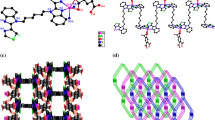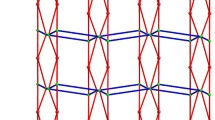Abstract
Three new Ni(II) coordination polymers exhibiting different 1D and 2D framework structures have been hydrothermally synthesized: [Ni(L 1)(1,3-BDC)(H 2O) 3] ⋅H 2O (1), [Ni(L 1)(1,3,5-HBTC)(H 2O) 3] (2), [Ni 3(L 2)3(1,3,5-BTC) 2(H 2O) 8] ⋅12H 2O (3) [L 1= N,N ′-bis(pyridin-3-yl)cyclohexane-1,4-dicarboxamide, L 2= N,N ′-bis(3-pyridyl)octandiamide, 1,3-H 2BDC = 1,3-benzenedicarboxylic acid, 1,3,5-H 3BTC = 1,3,5-benzenetricarboxylic acid]. X-ray single crystal diffraction analyses revealed that polymer 1 is a 2D interlaced layer based on the 1D [Ni(L 1)(1,3-BDC)(H 2O) 3] meso-helical chains. Polymer 2 is a 1D wave-shaped chain derived from the 1D [Ni(L 1)] n chain and monodentate coordinated 1,3,5-HBTC anions. Polymer 3 possesses an interesting 2D layer containing the trinuclear [Ni 3(1,3,5-BTC) 2] substructural unit and 1D zigzag [Ni(L 2)] n chain, representing a 3,4-connected {6 ⋅8 2} 2 {62⋅82⋅10⋅12} topology. Finally, the adjacent 1D chains or the 2D layers are connected through hydrogen bonding interactions to construct 3D supramolecular networks. Further, the thermal stability, solid state fluorescent property and photocatalytic activity of 1–3 have been investigated.

Three new Ni(II) coordination polymers have been hydrothermally synthesized by self-assembly of two bis-pyridyl-bis-amide ligands (L1, L2) and two aromatic polycarboxylates (1,3-H2BDC, 1,3,5-H3BTC). The thermal stability, fluorescent properties and the photocatalytic activities of polymers 1–3 have been studied.






Similar content being viewed by others
References
Qin J H, Ma L F, Hu Y and Wang L Y 2012 Syntheses, structures and photoluminescence of five zinc(II) coordination polymers based on 5-methoxyisophthalate and flexible N-donor ancillary ligands CrystEngComm 14 2891
Yoon M, Srirambalaji R and Kim K 2012 Homochiral Metal–Organic Frameworks for Asymmetric Heterogeneous Catalysis Chem. Rev. 112 1196
Moon H R, Lim D W and Suh M P 2013 Fabrication of metal nanoparticles in metal–organic frameworks Chem. Soc. Rev. 42 1807
Gai Y L, Jiang F L, Xiong K C, Chen L, Yuan D Q, Zhang L J, Zhou K and Hong M C 2012 Temperature-Dependent in Situ Reduction of 4,4 ′-Azobispyridine via Solvothermal Reaction Cryst. Growth Des. 12 2079
Liu B, Zhao R L, Yang G P, Hou L, Wang Y Y and Shi Q Z 2013 Two isostructural amine-functionalized 3D self-penetrating microporous MOFs exhibiting high sorption selectivity for CO 2 CrystEngComm 15 2057
Liu Y Y, Li J, Ma J F, Ma J C and Yang J 2012 A series of 1D, 2D and 3D coordination polymers based on a 5-(benzonic-4-ylmethoxy)isophthalic acid: Syntheses, structures and photoluminescence CrystEngComm 14 169
Suh M P, Park H J, Prasad T K and Lim D W 2012 Hydrogen Storage in Metal–Organic Frameworks Chem. Rev. 112 782
Cui Y J, Yue Y F, Qian G D and Chen B L 2012 Luminescent Functional Metal–Organic Frameworks Chem. Rev. 112 1126
Li Y W, Li D C, Xu J, Hao H G, Wang S N, Dou J M, Hu T L and Bu X H 2014 Structural modulation in two Cu II-based MOFs by synergistic assembly involving the mixed-ligand synthetic strategy and the solvent effect Dalton Trans. 43 15708
Li M, Liu L, Zhang L, Lv X, Ding J, Hou H and Fan Y 2014 Novel coordination polymers of Zn(II) and Cd(II) tuned by different aromatic polycarboxylates: Synthesis, structures and photocatalytic properties CrystEngComm 16 6408
Tian D, Li Y, Chen R Y, Chang Z, Wang G Y and Bu X H 2014 A luminescent metal–organic framework demonstrating ideal detection ability for nitroaromatic explosives J. Mater. Chem. 2 1465
Liu H Y, Yang J, Liu Y Y and Ma J F 2012 pH-dependent assembly of two inorganic–organic hybrid compounds based on octamolybdates: An unusual intercalated layer and a 3D 4-connected framework Dalton Trans. 41 9922
Gao Q, Xie Y B, Li J R, Yuan D Q, Yakovenko A A, Sun J H and Zhou H C 2012 Tuning the Formations of Metal–Organic Frameworks by Modification of Ratio of Reactant, Acidity of Reaction System, and Use of a Secondary Ligand Cryst. Growth Des. 12 281
Gu J Z, Kirillov A M, Wu J, Lv D Y, Tang Y and Wu J C 2013 Synthesis, structural versatility, luminescent and magnetic properties of a series of coordination polymers constructed from biphenyl-2,4,4 ′-tricarboxylate and different N-donor ligands CrystEngComm 15 10287
Hong D H and Suh M P 2014 Enhancing CO 2 Separation Ability of a Metal–Organic Framework by Post-Synthetic Ligand Exchange with Flexible Aliphatic Carboxylates Chem. Eur. J. 20 426
He Y B, Zhou W, Krishna R and Chen B L 2012 Microporous metal–organic frameworks for storage and separation of small hydrocarbons Chem. Commun. 48 11813
Brozek C K and Dincă M 2014 Cation exchange at the secondary building units of metal–organic frameworks Chem. Soc. Rev. 43 5456
Zhang H, Jiang W, Yang J, Liu Y Y, Song S and Ma J F 2014 Four coordination polymers constructed by a novel octacarboxylate functionalized calix[4]arene ligand: syntheses, structures, and photoluminescence property CrystEngComm 16 9939
Zhang H M, Yang J, Liu Y Y, Kang D W and Ma J F 2015 A family of coordination polymers assembled with a flexible hexacarboxylate ligand and auxiliary N-donor ligands: Syntheses, structures, and physical properties CrystEngComm 17 3181
Fan L M, Zhang X T, Sun Z, Zhang W, Ding Y S, Fan W L, Sun L M, Zhao X and Lei H 2013 Ancillary Ligands Dependent Structural Diversity of A Series of Metal–Organic Frameworks Based on 3,5-Bis(3-carboxyphenyl)pyridine Cryst. Growth Des. 13 2462
Lin L, Yu R M, Yang W B, Wu X Y and Lu C Z 2012 A Series of Chiral Metal–Organic Frameworks Based on Oxalyl Retro-Peptides: Synthesis, Characterization, Dichroism Spectra, and Gas Adsorption Cryst. Growth Des. 12 3304
Cheng P C, Kuo P T, Liao Y H, Xie M Y, Hsu W and Chen J D 2013 Ligand-Isomerism Controlled Structural Diversity of Zn(II) and Cd(II) Coordination Polymers from Mixed Dipyridyladipoamide and Benzenedicarboxylate Ligands Cryst. Growth Des. 13 623
Liu S J, Xue L, Hu T L and Bu X H 2012 Two new Co II coordination polymers based on carboxylate-bridged di- and trinuclear clusters with a pyridinedicarboxylate ligand: Synthesis, structures and magnetism Dalton Trans. 41 6813
Kan W Q, Wen S Z, Hu H Y and Kan Y H 2015 Cd(II) and Cu(II) coordination polymers based on aultidentate N-donor ligand: Syntheses, crystal structures, optical band gaps, and photoluminescence J. Coord. Chem. 68 2492
Sie M J, Chang Y J, Cheng P W, Kuo P T, Yeh C W, Cheng C F, Chen J D and Wang J C 2012 Interpenetrated and polycatenated nets of Cd(II) coordination networks from mixed N,N ′-dipyridyladipoamide and dicarboxylate ligands CrystEngComm 14 5505
Cheng J J, Chang Y T, Wu C J, Hsu Y F, Lin C, Proserpio D and Chen J D 2012 Highly interpenetrated diamondoid nets of Zn(II) and Cd(II) coordination networks from mixed ligands CrystEngComm 14 537
Cheng P C, Wu M H, Xie M Y, Huang W J, He H Y, Wu T T, Lo Y C, Proserpio D M and Chen J D 2013 Construction of N,N ′-di(3-pyridyl)adipoamide-based Zn(II) and Cd(II) coordination networks by tuning the isomeric effect of polycarboxylate ligands CrystEngComm 15 10346
Cheng P C, Kuo P T, Xie M Y, Hsu W and Chen J D 2013 Structure-directing roles of auxiliary polycarboxylate ligands in the formation of Zn(II) and Cd(II) coordination polymers based on a flexible N,N ′-di(3-pyridyl)dodecanediamide CrystEngComm 15 6264
Wang X L, Luan J, Lin H Y, Xu C, Liu G C, Zhang J W and Tian A X 2013 The design and construction of a series of metal–organic coordination polymers based on two isomericsemi-rigid bis-pyridyl-bis-amide ligands and three aromatic polycarboxylates CrystEngComm 15 9995
Wang X L, Luan J, Sui F F, Lin H Y, Liu G C and Xu C 2013 Structural Diversities and Fluorescent and Photocatalytic Properties of a Series of Cu II Coordination Polymers Constructed from Flexible Bis-pyridyl-bis-amide Ligands with Different Spacer Lengths and Different Aromatic Carboxylates Cryst. Growth Des. 13 3561
Wang X L, Luan J, Lin H Y, Lu Q L, Le M, Liu G C and Shao J Y 2014 Metal(II)–Organic Coordination Polymers Modulated by Two Isomeric Semirigid Bis-Pyridyl–Bis-Amide Ligands: Structures, Fluorescent Sensing Behavior, and Selective Photocatalysis ChemPlusChem 79 1691
Wang X L, Sui F F, Lin H Y, Zhang J W and Liu G C 2014 Multifunctional Cobalt(II) Coordination Polymers Tuned by Flexible Bis(pyridylamide) Ligands with Different Spacers and Polycarboxylates Cryst. Growth Des. 14 3438
Wang X L, Luan J, Lin H Y, Xu C and Liu G C 2013 Three multifunctional three-dimensional metal–organic frameworks based on a flexible N,N0-bis(3-pyridinecarboxamide)-1,6-hexane and 3-nitrophthalate: Syntheses, structures and properties Inorg. Chim. Acta 408 139
Muthu S, Yip J H K and Vittal J J 2002 Coordination networks of Ag(I) and N,N ′- bis(3-pyridinecarboxamide)-1,6-hexane: Structures and anion exchange J. Chem. Soc. Dalton Trans. 31 4561
Hsu Y F, Hsu W, Wu C J, Cheng P C, Yeh C W, Chang W J, Chen J D and Wang J C 2010 Roles of halide anions in the structural diversity of Zn(II) complexes containing the flexible N,N ′-di(4-pyridyl)adipoamide ligand CrystEngComm 12 702
Shi X, Zhu G S, Fang Q, Wu G, Tian G, Wang R, Zhang D, Xue M and Qiu S L 2004 Novel Supramolecular Frameworks Self-Assembled from One-Dimensional Polymeric Coordination Chains Eur. J. Inorg. Chem. 2004 185
Shi X, Zhu G S, Wang X H, Li G H, Fang Q R, Zhao X J, Wu G, Tian G, Xue M, Wang R W and Qiu S L 2005 Polymeric Frameworks Constructed from a Metal-Organic Coordination Compound, in 1-D and 2-D Systems: Synthesis, Crystal Structures, and Fluorescent Properties Cryst. Growth Des. 5 341
Hsu Y F, Hu H L, Wu C J, Yeh C W, Proserpioc D M and Chen J D 2009 Ligand isomerism-controlled structural diversity of cadmium(II) perchlorate coordination polymers containing dipyridyladipoamideligands CrystEngComm 11 168
Sun G M, Huang H X, Tian X Z, Song Y M, Zhu Y, Yuan Z J, Xu W Y, Luo M B, Liu S J, Feng X F and Luo F 2012 Carboxylate-assisted acylamide metal–organic frameworks: Synthesis, structure, thermostability and luminescence studies CrystEngComm 14 6182
Lv J, Lin J X, Zhao X L and Cao R 2012 Photochromic hybrid materials of cucurbituril and polyoxometalates as photocatalysts under visible light Chem. Commun. 48 669
Gong Y, Wu T and Lin J H 2012 Metal–organic frameworks based on naphthalene-1,5-diyldioxy-di-acetate: Structures, topologies, photoluminescence and photocatalytic properties CrystEngComm 14 3727
Guo J, Yang J, Liu Y Y and Ma J F 2012 Two novel 3D metal–organic frameworks based on two tetrahedral ligands: Syntheses, structures, photoluminescence and photocatalytic properties CrystEngComm 14 6609
Acknowledgements
This work was supported by the National Natural Science Foundation of China (No. 21471021, 21501013, 21401010), New Century Excellent Talents in University (NCET-09-0853) and Program of Innovative Research Team in University of Liaoning Province (LT2012020).
Author information
Authors and Affiliations
Corresponding authors
Additional information
Supplementary Information (SI)
X-ray crystallographic data for polymers 1–3 reported in this paper have been deposited in the Cambridge Crystallographic Data Center with CCDC reference numbers CCDC 1041874 for 1, 1435170 for 2 and 1435171 for 3. These data can be obtained free of charge from The Cambridge Crystallographic Data Centre via www.ccdc.cam.ac.uk/data_request/cif. The tables of selected bond lengths and angles, the related hydrogen bonding geometries of polymers 1–3 (Tables S1–S4), and additional figures (structural figures, IR spectra, PXRD and TG curves, Figures S1–S12) are available in Supplementary Information; see, www.ias.ac.in/chemsci.
Electronic supplementary material
Below is the link to the electronic supplementary material.
Rights and permissions
About this article
Cite this article
LIN, H., SUN, J., LIU∗, G. et al. Self-assembly, structures and properties of three new Ni(II) coordination polymers derived from two different bis-pyridyl-bis-amide ligands and two aromatic polycarboxylates. J Chem Sci 129, 9–20 (2017). https://doi.org/10.1007/s12039-016-1213-y
Received:
Revised:
Accepted:
Published:
Issue Date:
DOI: https://doi.org/10.1007/s12039-016-1213-y




